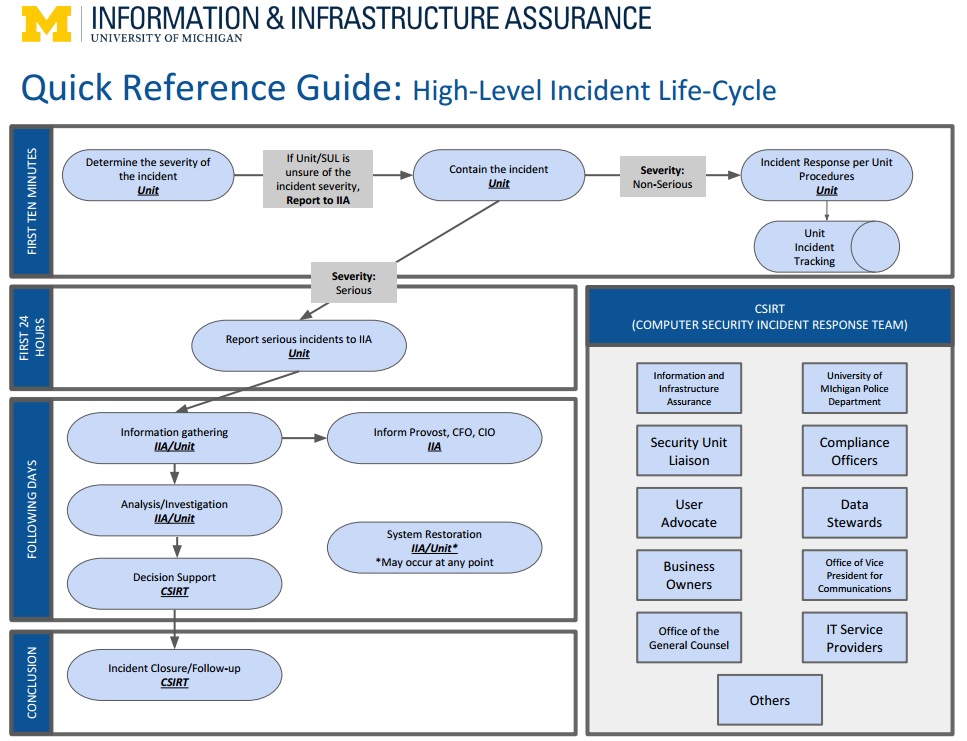These guidelines:
- Describe how Information Assurance (IA) and U-M units work together to respond to and coordinate IT security incidents.
- Outline specific IT security incident roles and responsibilities for both IA and U-M units.
Units can use the guidelines:
- As a guide for development of internal processes and procedures for IT security incident response.
- To inform IT staff and unit leadership about IT security incident response processes and responsibilities at U-M.
U-M staff with IT security responsibilities play a critical role in IT security incident response. IA provides the following guidance for IT security staff within campus units, to help the university respond to IT security incidents as defined in the university's Information Security Incident Reporting (SPG 601.25).
In general, the goals of IT security incident response at the University of Michigan are to:
- Minimize negative consequences of information security incidents, and improve the university's ability to promptly restore operations.
- Enable prompt incident response decisions to be made by appropriate stakeholders.
- Proactively reduce the exposure of the university to information security incidents by employing consistent incident management processes that incorporate lessons learned from past incidents.
- Satisfy federal, state, and industry regulations that require improved protection of sensitive and private information, and timely disclosure of potential breaches to affected individuals.
- Establish a framework and appropriate metrics for consistently prioritizing information security investments across the university.
- Promote awareness and education of the U-M community relevant to incident avoidance, detection, reporting, and handling.
Communication During an Incident
Units should rely on IA to manage and coordinate communication during an incident—both within the group of people working on the incident and on any notifications to leadership, users, or others. IA will ensure the appropriate communication cadence and level of detail so people have the information they need and are not unduly alarmed and that the investigation is not jeopardized. Units are asked not to communicate about an incident without first working with IA.
Incident Lifecycle
The incident lifecycle processes are depicted in Figure 1 below. They include the following:
Incident Detection and Reporting
The incident detection process involves observation of malicious or anomalous activity, and gathering of information that provides insight into security threats or risks. Reports of threats from sources external to U-M may also trigger an incident report. Risks, threats, and vulnerabilities that meet the SPG 601.25 definition of information security incidents are forwarded to the designated Security Unit liaison. Information security incidents that are detected by any users of U-M information resources (including computer theft or loss) are also reported to the Security Unit liaison per SPG 601.25. As noted in the SPG, incidents should be reported to the Security Unit liaison as soon as possible but no later than 24 hours from the time they are initially detected.
Incident Severity Classification
Incidents that meet the Serious Incident criteria as defined in SPG 601.25 must be centrally reported to [email protected]. All other Non-Serious incidents are to be handled by the unit using unit level procedures for incident response, which include incident tracking and monitoring using any automated or manual tool selected by the unit. In the case of a MiWorkspace unit, IA will take the lead and handle Non-Serious incidents.
Incident Response Process
The Incident Response Process is designed to provide a high level guide for effective planning, communication, and response in the event of a IT Security Incident. The responsibilities assigned to the Security Unit Liaison may be performed by a person or group designated by the Security Unit Liaison in coordination with IA.
Preparation (Preparing incident response tools and IT staff for when an incident occurs)
| Unit | IA |
|---|---|
|
|
Identification (Determining where the incident occurred and the incident severity)
| Unit | IA |
|---|---|
|
|
Containment (Limiting the incident damage as quickly as possible)
| Unit | IA |
|---|---|
|
|
Eradication (Removing the cause of the incident)
| Unit | IA |
|---|---|
|
|
Recovery (Restoring affected systems to normal operational status)
| Unit | IA |
|---|---|
|
|
Lessons Learned (Serious Incidents)
| Unit | IA |
|---|---|
|
|
Incident Reporting (Serious Incidents)
All serious incidents, including incidents where the Security Unit liaison is not sure whether the incident is serious or what type of information might be involved, must be reported to IA. Any serious incidents that are reported or forwarded to IA should include the following:
- Time(s) of occurrence
- Systems/applications/devices potentially involved
- Actions taken
- Types of sensitive data that may be involved
- Potential business impacts of action or inaction
- Include contact details for business owners and technical staff involved
- Has unit leadership/ISL/SUL has been informed?
Reporting of serious incidents to IA must occur as soon as possible, but no more than 24 hours from discovery of the incident.
Roles and Responsibilities
- For roles and responsibilities of members of the CSIRT, please refer to Incident Response Operating Level Agreement (OLA).
- For other information about security roles and responsibilities, please refer to Incident Response Roles and Responsibilities (U-M Login required).

